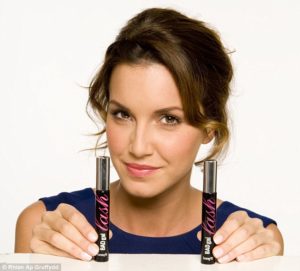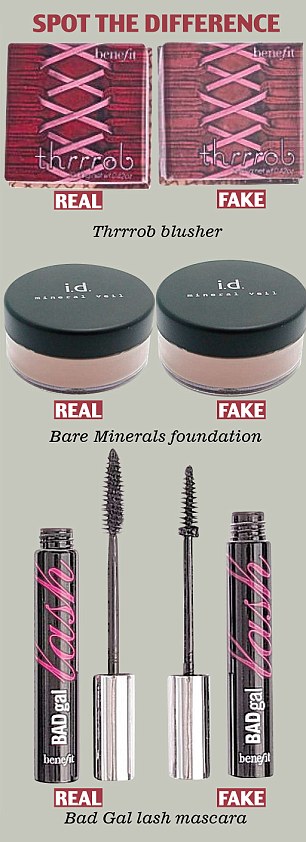By Charlotte Kemp for the Daily Mail
How counterfeit cosmetics containing dangerous levels of arsenic are being sold online to unsuspecting bargain hunters
When Mandy Lanham saw her favorite foundation for sale online at a greatly reduced price she snapped it up — after all, few of us can resist a beauty bargain.
The product — called Some Kinda Gorgeous and made by popular cosmetics brand Benefit — was being sold new on eBay by a seemingly reputable seller and duly arrived a few days later.
Having saved £10 on the recommended retail price of £23.50, Mandy, 48, a part-time teacher from East Sussex, was quietly smug.
Beauty products also effected: One of these mascara’s by Benefit cosmetics is genuine and the other, bought online, is a counterfeit containing dangerous levels of arsenic
‘I thought it was a very good price but not so cheap that I was suspicious,’ she says. ‘I’d been looking for presents for my daughters when I spotted it. I checked out the ratings of the seller and all the feedback from customers was positive. The packaging in the picture looked convincing, too.’
Alarm bells only started ringing when the product arrived and Mandy put the make-up on her face.
‘It felt sticky and unpleasant on my skin and I noticed the medium shade I’d chosen wasn’t the same as the old one that I’d bought from a Benefit counter in a department store. It didn’t smell the same either,’ she says.
The following morning, Mandy’s skin had flared up. Her face felt tender and puffy and it took a few hours for the swelling to go down. Mandy had unwittingly bought a fake — a fact confirmed when she contacted trading standards officers.
Even though the compact looked the part, the foundation inside was nothing like the real thing. Far more worrying, though, was the fact that something in Mandy’s bogus foundation triggered an allergic reaction.
FALSE PROFITS
Profits made from counterfeit make-up are used to fund drugs smuggling and terrorism, say Interpol
For this is the shocking flipside to the shadowy world of counterfeit cosmetics.
The cheaper imitations that are flooding the market may look legitimate — as well as please the purse — but they have been found to contain ingredients that at best irritate the skin and which could, in the worst cases, cause permanent damage to both the body and the brain.
Out of ten items of designer make-up we purchased online in the past two weeks, eight were found to be counterfeit when the packaging and the product were compared with the genuine article.
When we asked Staffordshire Scientific Services to test the products using the same methods trading standards officers employ, all the fakes were found to contain a cocktail of potentially harmful ingredients ranging from lead, copper and mercury to arsenic and cadmium, a metal which is highly dangerous.
A counterfeit MAC eyeliner sold on Amazon at £3.50 (it normally sells at £14) contained 46 times the permitted level of copper, making it unfit for use on eyes.
Worryingly, dermatologists are now reporting a rise in the number of women with skin conditions triggered by the use of counterfeit make-up. These can range from acne and swelling to more serious skin conditions, such as psoriasis.
‘It’s only a matter of time before someone gets seriously hurt,’ says Christine Heemskerk, of the Trading Standards Institute.
She warns: ‘These counterfeit cosmetic products may not have been made in a sterile environment. They may contain carcinogenic ingredients that are banned from use in cosmetics and could cause long-term harm.
‘They may trigger rashes and eye infections as well as more serious conditions such as lead poisoning, which can affect major organs, causing problems for the heart, kidneys and nervous system.’
THE HORRIFYING CHEMICAL COCKTAIL WE FOUND
The Mail bought a bag of randomly selected designer make-up on eBay and Amazon, all being sold as ‘new’ at bargain prices. Eight out of the ten products turned out to be fakes, and we had them tested by Staffordshire Scientific Services, a lab used by trading standards officers. Here are the five worst offenders.
- MAC kohl eyeliner pencil bought on Amazon Marketplace
High Street price: £14
Fake price: £3.50
Identical packaging but the fake pencil had a smaller lid and the writing could be scraped off easily. This was found to contain 46 times the permitted level of copper at 2300mg/kg. Copper is not as toxic as lead and cadmium but it can trigger vomiting or an allergic reaction. It was considered unsafe under The Product Safety Regulations 2005.
2. Thrrrob blusher by Benefit Cosmetics bought on eBay
High Street price: £23.50
Fake price: £6.49
Convincing box — but no batch number. Contained traces of cadmium, copper, arsenic, lead and mercury as well as worrying levels of bacteria.
3. Benefit Eye Bright pencil bought from eBay
High Street price: £14
Fake price: £1.89
Convincing box but the pencil lid was a different size and the product was chalky, pale and crumbly. Contained traces of lead, copper and arsenic.
4. Bare Minerals Mineral Veil foundation powder bought on eBay
High Street price: £20
Fake price: £10.89
Very carefully copied, down to the instructions inside, but the writing on the pot was different and there was no batch number. Contained traces of lead, cadmium, copper, arsenic and mercury.
5. Bad Gal lash mascara by Benefit Cosmetics bought on eBay
High Street price: £16.50
Fake price: £3.99
Looked the part but the contents were thick and gloopy with a sickly sweet smell and had a different brush. This contained lead and traces of copper, arsenic, mercury and cadmium.
As she points out, the manufacture of genuine cosmetics is strictly controlled and products are rigorously tested before they go on sale. But the counterfeiters churning out the cheap versions do not abide by any of these rules, so along with potentially harmful metals, other banned substances may be used.
Paint stripper and nail varnish remover has been found in fake mascara and liquid eyeliners. And a batch of counterfeit perfume seized by the police contained urine as a substitute to stabilizers used in the genuine product.
What makes this trade worrying is the fact this new generation of beauty fakes are so convincing. They’re widely available on reputable online sites including eBay and Amazon, with sellers buying in stock from Chinese wholesalers or shady middlemen in the UK.
In the most recent prosecution, Leanne Wertheim, a 24-year-old mother from Gilwern in Monmouthshire, was caught trying to sell £40,000 worth of poisonous Chinese-made copies.
A health care worker, Wertheim used four separate eBay accounts to sell fake beauty products — including brands such as Max Factor, MAC, Lancome and Bobbi Brown — from her bedroom. She enticed customers by offering what appeared to be amazing bargains, selling new products worth £30 for as little as £3.99.
Some buyers complained about the quality, but she insisted the items were authentic and it was only when trading standards investigators bought some themselves that she was exposed.
Tests revealed some of the fake products were actually poisonous: one counterfeit Max Factor mascara contained more than three times the legal amount of lead.
HOW TO TELL A FAKE
- Only buy online from a licensed seller. All the beauty brands list these on their websites.
- Scan the packaging and the product for a batch number — it should be printed on the base or there will be an imprint on the box.
- Compare lids or applicator brushes with the genuine product. The fake ones are often a different size.
- Look carefully at the fonts used on the product packaging. They are often slightly different in size from fonts used on the genuine article.
- Notice any difference in the colour of the packaging.
Wertheim admitted five charges under the Trade Marks Act. She was given an eight-month suspended prison sentence, 160 hours of community service and ordered to pay £2,000.
But she is one of many cashing in on the booming trade for counterfeit cosmetics. MAC recently took legal action after claiming counterfeit items were being sold at the shop Target in Australia. It shows how good the copies are becoming that a High Street chain may have been duped into stocking them.
Benefit Cosmetics UK, owned by luxury giant LVMH, recently employed the services of a UK-based company that specialises in tracking down consignments of counterfeit goods.
The popular brand is still reeling from a seizure by Coventry Trading Standards last year when a fake Benefit Bad Gal Lash mascara was found to contain dangerous levels of mercury.
Internet forums are alive with tales of women who have been stung by cheap rip-off make-up. In one YouTube video posted online this summer, an attractive psychology graduate living in Oxford gives a salutary warning about the dangers of buying cheap counterfeits. After applying a fake blusher, she says, ‘My face was swollen, my eyelids were swollen and my face was really itchy.’
Her GP prescribed an antihistamine cream and the symptoms went down within a few days. But she learned her lesson. ‘I have realized it was a silly thing to do. I am never going to buy anything like that on the internet again. You don’t know what you are putting on your face,’ she said.
A spokesperson for eBay insists the website is clamping down on counterfeiters. In response to our investigation, they said: ‘eBay does everything it can to tackle the sale of counterfeits, which is a global issue and not limited to online shopping.
‘We work in partnership with thousands of leading brands, as well as law-enforcement agencies and have established a comprehensive program for reporting items and removing those that cause concern.’
Amazon says: ‘Amazon.co.uk does not allow the sale of counterfeit items on its Marketplace platform.
Any seller found doing so will be subject to action from Amazon, including removal of their account.
‘Occurrences of counterfeit products on Amazon.co.uk Marketplace are rare and we have an established process in place that enables third parties, including rights holders, to provide us with notice of counterfeit product.’
That’s all very well, but unless tougher action is taken, unsuspecting women on the hunt for a beauty bargain will be the ones who pay the price.
Find the original article HERE.


